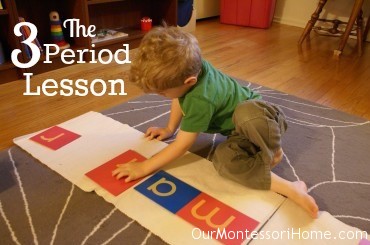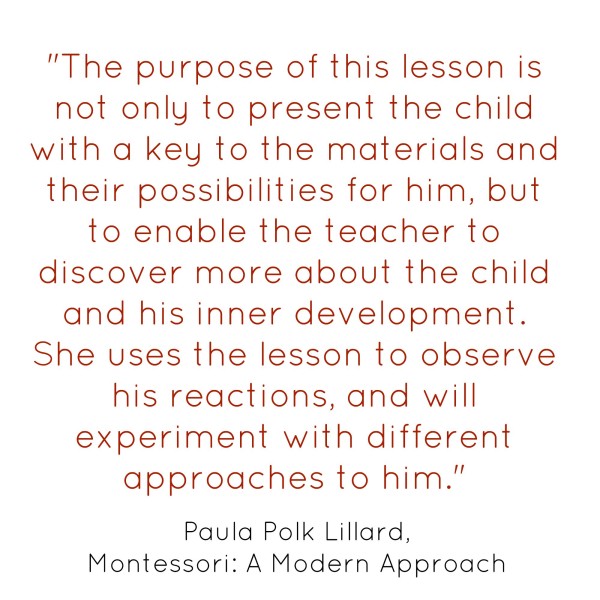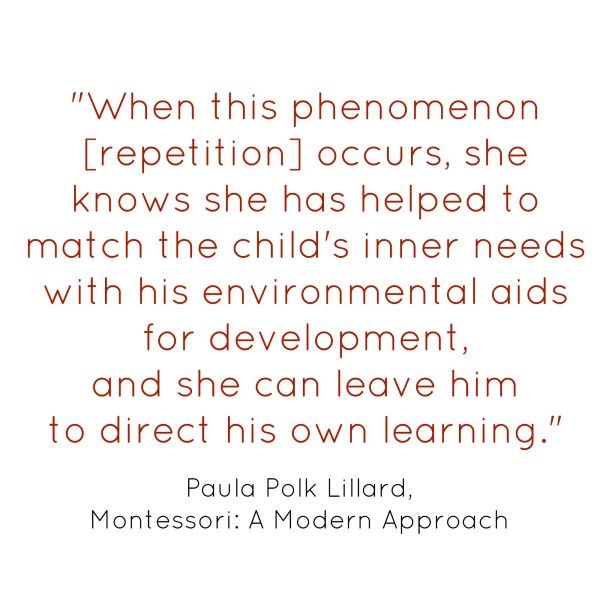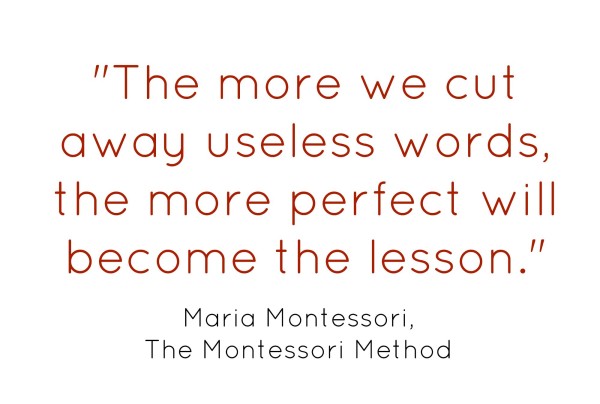As we’ve headed back to school, I’ve been doing some reviewing of my own with the Montessori 3-period lesson. It’s one of those things that I got use to and then…a little too relaxed on. Sometimes I’d find myself showing a new work and forgetting to follow the 3-period lesson. Not always a big deal, but I like to think if my kids ever transition to a traditional Montessori school most of the order and routine will be the same (if not familiar), so my goal is to maintain that structure.
I’ve pulled out two of my favorite Montessori books: The Montessori Method and Montessori: A Modern Approach to review the actual lesson and the reasoning behind it.
***
The Why Behind the 3-Period
The lesson is a brief time when the teacher takes the initiative and directs the child. This is probably one of my biggest struggles in our classroom. Without having the community of other children, Joey is more hesitant to choose his own work and stay focused. In turn, I end up introducing or suggesting more activities.
Quoting Montessori, Lillard writes,
“The Fundamental Lesson is defined as “a determinate impression of contact with the external world; it is the clear, scientific, pre-determined character of this contact which distinguishes it from the mass of indeterminate contacts which the child is continually receiving from his surroundings” (Lillard, 66).
In order for the child to best receive the lesson, the teacher must be practiced in giving a lesson and the material as to not distract from the child absorbing the material and/or concept.
The lesson should be short, simple, and to the point. The teacher’s aim is to give the lesson with as few words as possible.
“By using few and simple words, the teacher can more readily convey the truth that lies hidden in the materials” (Lillard, 66).
As the teacher remains small, so to speak, the child is able to focus on the material.
The teacher demonstrates the lesson and then invites the child to use the material in the same way. At this time, the teacher sits with the child to observe their actions, but not interfering. By observing the child, the teacher will know whether the material interests the child and if is, in fact, ready for the material.
Of the lesson, Montessori said,
“If, therefore, the lesson rigorously prepared in this brevity, simplicity, and truth is not understood by the child, is not accepted by him as an explanation of the object, the teacher must be warned of two things: first, not to insist by repeating the lesson; and second, not to make the child feel that he has made a mistake, or that he is not understood, because in doing so she will cause him to make an effort to understand, and will thus alter the natural state which must be used by her in making her psychological observation.”
In other words, the child’s lack of interest shows that he or she is not ready for the material, don’t push it. Put it away and do it again another day. If the child did show readiness, the teacher can make a simple encouragement and leave the child with their work. The teacher then looks for repetition of the activity, knowing that “repetition occurs only if the child has understood the idea the exercise represents, and if this idea corresponds to an inner need of the child” (Lillard, 67).
I think the hardest adjustment for me is the continual realization that it’s not about getting through the most material and finding some measurable success in the child. When I do that it becomes more about me than the child and his development and needs! I need to leave room for my children to make their discoveries at their own pace and milestones, not mine.
Another point Lillard makes is to let the child discover the materials in new ways. During repetition, the child will naturally create new ways to use the material by combining several interrelated activities or comparing the material to others in the environment, thus coming up with “creative possibilities hidden within the design of the materials” making a burst of “creative activity possible” (68).
The goal is to not to “pre-empt the child’s right to make his own discoveries with the Montessori materials, by showing him more than their basic idea and robbing the joy of creativity (Lillard, 69).
The 3-Period Lesson
After the concept has been established in the child, the teacher introduces the exact nomenclature to correspond to the new concept (69). Lillard seems to be saying the child is given a demonstration of an activity and invited to do the activity, before having the actual 3-period lesson. This was the first time I’d heard this. I’d be interested to hear what your thoughts, experience, and opinions.
The First Step, “This is…” (Naming)
The teacher associates the name of the object with the abstract idea it represents. Once again, the teacher is careful to keep the language simple.
Using the sandpaper letters as an example, the teacher would lay 2 – 3 letters on the mat and pointing to one letter would say, “This is c.” The teacher would then trace the letter c 2-3 times saying the phonetic sound each time. The teacher would then invite the child to do the same. The teacher would then repeat this cycle with each letter.
The Second Step, “Can you show me…” (Recognition & Association)
“The teacher tests to see if the name is still associated in the child’s mind with the object” (Lillard, 69). Continuing the with the example of the sandpaper letters, the teacher would ask, “Can you show me c?”
If the child doesn’t notice the association, don’t repeat the lesson, but wait for a more opportune time.
The Third Step, “What is this…” (Recall)
At the final step, the teacher asks the child to name the activity or concept or as Lillard says, to “pronounce the appropriate vocabulary” (70).
Pointing to sandpaper letter c the teacher may say, “What is this?” The child, if ready, will respond with the phonetic c.
Videos of 3-Period Lessons
- Three-Period Lesson with the Stamp Game
- Lesson with Sandpaper Numbers
- Lesson with the Pink Tower
- Lecture on Teaching Words using the 3-Period Lesson by Margaret Homfray, student and colleague of Maria Montessori.
Further Reading:
- Montessori: A Modern Approach
, Paula Polk Lillard (Chapter: The Montessori Method, pages 65 – 70)
- The Montessori Method
, Maria Montessori (Chapter: How the Lesson Should Be Given)
- The Three-Period Lesson from NAMC Montessori Teacher Training
- How to Give a Montessori 3 Period Lesson from Montessori Print Shop
- Montessori Basics 1: The 3-Period Lesson from Montessori for Everyone
*post contains affiliate links


































1 comment… add one
Thanks for sharing. Maria Montessori was a woman ahead of her time and how sad that she lived in another era but what a legacy she left behind.